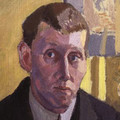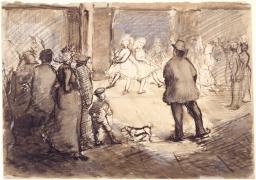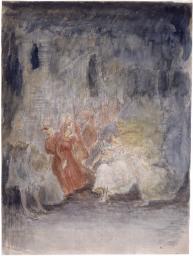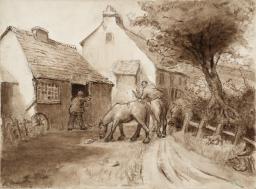Albert Rutherston, ‘From Orpen and Gore to the Camden Town Group’
The Burlington Magazine, vol.83, no.485, August 1943, pp.201–5.
FROM ORPEN AND GORE TO THE CAMDEN TOWN GROUP
BY ALBERT RUTHERSTONE
MY first meeting with Sickert – Walter Sickert he was then and I prefer to think of him by this name rather than by his second name “Richard” which he used many years later – took place at Lefèvre’s in Dieppe, that delightful little hotel where each summer were to be found Max Beerbohm, William Nicholson, Reginald (“Reggie”) Turner and Marcel Boulestin, among a small number of guests, mostly French. Turner was then writing “London Day by Day” in the Daily Telegraph. Boulestin was secretary to Willy, the well-known Parisian author, journalist and viveur, husband to Colette; Boulestin was as distinguished then as famous now, for his love and knowledge of superlative wines and food.
The year was 1900. I had set off to paint abroad for the first time alone, in order to explore Cany and its surrounding countryside, situated some twenty or thirty miles from Dieppe, since William Orpen and I had been told that there we might find a pleasant place to live and paint in for our holiday. In my youthful enthusiasm I took the night boat from Newhaven, arriving at Dieppe shortly before dawn. Disembarked upon the quay-side I felt as hungry as I was inexperienced. The train for Paris left and I remember a sense of surprised indignation when I found the cafés on the Quai Henry Quatre closed and silent. Of the possible amenities on the other side of the Harbour I was then both ignorant and afraid.
And so I spent my time wandering about that part of Dieppe with which a year previously I had made, at the age of seventeen, slight acquaintance. Towards half-past six I found signs of life at last in the little café which was a part of Lefévre’s [sic]. Thankfully I went in to be told by Jeanne, the maid, that my friends Max and Reggie were still in bed and certainly asleep. I think this charming girl, for Jeanne was that, felt some curiosity as well as amusement at my ill-timed appearance at this highly civilised although small hotel. She brought coffee and brioches, then at my shameless request went upstairs to wake, not Max indeed, but Reggie – to announce my quite unlooked-for arrival. And Reggie Turner, always one of the kindest as he was one of the wittiest of men, actually came down to greet me, within the half-hour, cordial and fully dressed, an act deserving surely one of those civil decorations which after 1914 became all too common for far lesser displays of gallantry. Nor did he allow any sense of embarrassment to be seen on finding me dressed in a pair of peg-topped mole-coloured corduroy trousers, purchased on my first visit to France, together with an almost white herringbone-patterned jacket made by a Portland Street tailor. Later, a delightful lunch with Max and Reggie; half-way through, Walter Sickert came in carrying canvas, or maybe several canvases, paint box and easel. I was introduced as “Will’s (William Rothenstein’s) brother, now at the Slade School, also an artist.” How delighted I was, how excited – nor had I any suspicion of how much I should come to dislike, in later years – great as my admiration and affection for my older brother has been always and is – to be so introduced. At that [end of p.201] time it was, of course, both right and proper.
Sickert was kindness and courtesy itself, putting me completely at my ease. When he left to return to work I was invited to go to see him – “Oh, I was going off to Cany” – “Well, the next time you are in Dieppe.”
Cany proved by no means easy of access. A journey in those days of some hours of tedious travelling, changing and waiting. It appeared to be, however, an ideal spot for work; a telegram brought Orpen over from London within the twenty-four hours. I had found admirable living quarters in the Hotel du Commerce – when I drove there just before the present war it was unchanged but for the absence of the postes-chaises in the courtyard and of our hostess Madame Caillebotte-Hardy, a handsome woman whose husband was, as any one could realise at the time, drinking heavily and gambling away too, a prosperous good-will. We settled quickly to work. Miss Emily Scoble came over from London to sit for us and later Charles Conder came from Paris.
Of Emily Scoble, Orpen painted then what in my opinion is one of his best pictures – The English Nude. In Konody’s and Dark’s book Sir William Orpen, the date of it is wrongly guessed at as 1906, an error that may be excused, perhaps, on the ground that its date was not recorded on the canvas. He painted of her also whilst at Cany, a small nude out-doors, in a wood – a picture which I have not seen since although it was sold, I remember, soon after his return to London.
Orpen’s work at this early period had an intensity of execution which later he never achieved. He had already painted The Mirror before coming to Cany and after his return, A Mere Fracture [Plate I, b] followed together with other paintings of a similar genre. After this his work had more obviously brilliant qualities of both skill and technique, but this brilliance had a certain superficiality, less satisfying than the more solid qualities of these early paintings.
The summer passed very pleasantly, and as is the way – all too quickly. Conder, always the best of company, did enchanting work. I was still a student at the Slade, Orpen had left it the previous year – so that I had to return to visit my parents in Bradford before appearing at Gower Street for the autumn term. Emily Scoble chose the same moment for departure; we set off together, leaving Conder and Orpen behind. The opportunity had been lost for the moment of taking advantage of Sickert’s invitation.
Neither the summer following nor the next did I go to France for a working holiday, but on several occasions I went over for short visits at which times I met Sickert. I held him indeed in high hero worship; his work and personality fascinated me so much that I knew no other gateway to France than Dieppe.
The year 1904, however, found me painting again at Cany together with my friend Spencer Gore; once again Emily Scoble came over to sit, when I painted her in one of the draped and canopied beds of the Hotel du Commerce, a picture [Plate II, a] last shown at, and vanished mysteriously from, a once well-known gallery in Bond Street. I had left it there on sale in 1916 before going out to serve in Palestine. I have never seen or heard of this picture since.
Gore had a great admiration for Sickert’s work. The temptation to act as his cicerone was sufficient excuse for a short respite from work. We left for Dieppe where we spent two delightful days and evenings in Sickert’s company. It was during this visit that Sickert was persuaded to make up his mind to return to live in London. He was beginning to tire, I believe, of his complete isolation in Dieppe. Gore and myself were full of enthusiasm for what was happening in our particular London world. The New English Art Club was then at its zenith, its more famous members re-inforced by the advent of Augustus John, his sister Gwen, Orpen, McEvoy, Edna Clarke Hall and others, whose work was adding a powerful new vitality and interest to its exhibitions.
Sickert had heard of the work of these, our contemporaries; he had not then seen it. His interest was, I think, aroused. At the end of our stay he promised us to return and return he did, if my ever-faulty memory for dates is not mistaken, in the early spring of the following year.
A suitable studio was quickly found in Fitzroy Street where Gore was living at No. 21, myself opposite at No. 18. Sickert lost no time in taking up that rapport with a London life which his long absence abroad had cut short. He appeared to resume it as though there had been no interruption. To the delight of all of us, the Old Bedford Music Hall, The Mogul in Drury Lane, the Canterbury under Charing Cross and the Metropolitan, became again, turn in, turn out, subjects for his brush and pencil.
I was fortunate at that moment in having several Coster girls as models for a series of paintings I was at work upon – The Laundry Girls (Tate Gallery) [Plate II, b] [sic] was one, and Emily, the younger of the two [Plate II, b] who sat for this, blonde, amusing and pert, found great favour in the eyes of Sickert, who delighted to draw and paint her. He renewed old friendships, his paintings, long absent from the exhibitions of the New English Art Club re-appeared there, and he was generous in his instant recognition of the new generation about whom Gore and I had spoken at Dieppe. It was a stirring time; Conder had returned earlier to London – a new vitality was in the air.
Sickert seemed to become at once our natural leader, possibly because he lived more intimately with us than gods of longer standing, in spite of their friendly hospitality, like Steer, Tonks, Fred Brown [end of p.202] [beginning of p.205] and others. His methods of work, his way of life, his wit, brought a fresh and inspiring atmosphere. Above all he seemed the perfect cosmopolitan figure who had worked alongside Degas, who knew France intimately and had won our admiration by his work of Dieppe and Venice together with that of the earlier London of the 1890’s. And from Fitzroy Street he would still send, when in need of money, packages of small paintings, twenty or so at a time, to Bernheim Jeune’s in Paris, for each of which he would receive 100 francs. It appeared to be, indeed, what many of us had been waiting for.
Some six months after his return he suggested to Gore and myself that a room should be taken where we could show our paintings and drawings; there would be few expenses, he pointed out, apart from rent and these could be met from a small deduction, by way of commission, on sales.
The idea was promptly acted upon and a suitable room taken at No. 19 Fitzroy Street, where we began to be “at home” to our friends and any other people who might be interested, each Saturday afternoon. After a short time Augustus John also sent drawings to be shown and we were joined by Lucien Pissarro and his talented daughter Orovida. There were also others whose work was invited. Among these were Percy Wyndham Lewis, G. H. [sic] Lightfoot, J. D. Innes and Derwent Lees, the last three then just emerging from the Slade.
We had many visitors and a steady sale of work by all of us resulted. Our Saturday afternoons became well-established, too, in the social sense. Mrs. George Swinton, Philip and Lady Ottoline Morrell, George Moore, Jacques Blanche, Mr. and Mrs. Julian Lousada, Miss Hudson, Miss Sands, Humbert Wolfe, Mr. John Fothergill, Mr. Randall Davis and Mr. Michel Salaman were among those who were staunch supporters.
My personal participation was cut short after about three years by a long and serious illness. On recovery I went abroad for a considerable time to convalesce and paint. Returning to London I found changes had taken place at 19 Fitzroy Street. Robert Bevan and Charles Ginner were newcomers there and I felt the character of the “at homes” to be somehow different. This became more evident when later Harold Gilman, back from a long period of study in Madrid, joined the company. Augustus John’s work seemed to be absent, and J. D. Innes, for whose work I had the greatest admiration, was no longer showing it there. Sickert and Gore had left Fitzroy Street, and were living in Camden Town.
A year or two elapsed during which time we continued in much the same way with Gore and myself spending working holidays together, once at Billy in the Bourbonnais, once at Brandsby in Yorkshire, on both of which occasions we were joined by Walter Russell and his wife, Lydia. Then I again left London to join my friends Gerard Chowne and his wife at Grasse in the Alpes Maritimes. This was in January 1910. When in May of the same year I returned it was to be in time to take part in the winding up of No. 19. From the ashes a new group was being formed, to be known as the Camden Town Group.
Gore had written to hint at this, sounding me as to my feelings in the matter. We were intimate friends and during my absence corresponded freely. He was aware that my own outlook and work were undergoing a change. In this he was right and I decided on a solitary path. The idea of a group of a more formal character appealed to me as little then as now.
The character and personalities of the Camden Town Group are well-known. To suggest only from what roots it sprang is the purpose of this article.
***
Reproduced courtesy of the artist’s grandchildren
Note
The illustrations in Albert Rutherston’s article are as follows (captions are provided in the original style):
PLATE I, A – THE WICKED ELDERS OF CANY AND THE INNOCENT SUZANNE. CARICATURE BY SIR WILLIAM ORPEN. 1900. PEN DRAWING, 19.6 by 25.4 cm. (PRIVATE COLLECTION)
PLATE I, B – A MERE FRACTURE. SIR WILLIAM ORPEN. 1900. CANVAS, 94 by 100 cm. (THE LATE MR. GEOFFREY BLACKWELL)
PLATE II, A – NUDE IN BED. BY ALBERT RUTHERSTON. 1904. CANVAS, 61 by 46 cm. (PRESENT WHEREABOUTS UNKNOWN)
PLATE II, B – EMILY. BY ALBERT RUTHERSTON. PEN AND WASH DRAWING, 30.5 by 23.5 cm. (IN POSSESSION OF THE ARTIST)
PLATE II, C – THE LAUNDRY GIRLS. BY ALBERT RUTHERSTON. 1905. CANVAS, 91 by 117 cm. (TATE GALLERY) [Tate N04996]
How to cite
Albert Rutherston, ‘From Orpen and Gore to the Camden Town Group’, in The Burlington Magazine, vol.83, no.485, August 1943, pp.201–5, in Helena Bonett, Ysanne Holt, Jennifer Mundy (eds.), The Camden Town Group in Context, Tate Research Publication, May 2012, https://www




